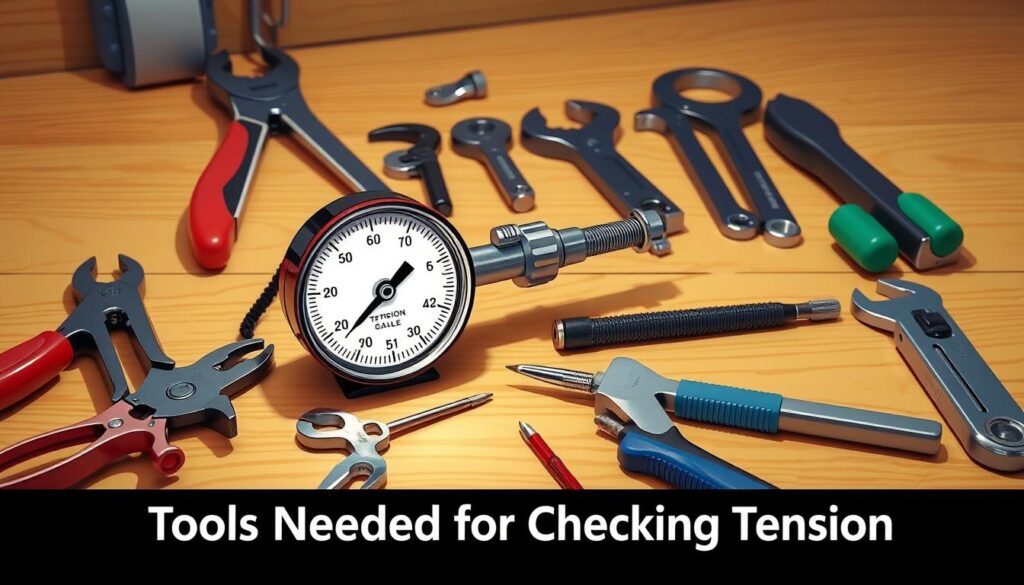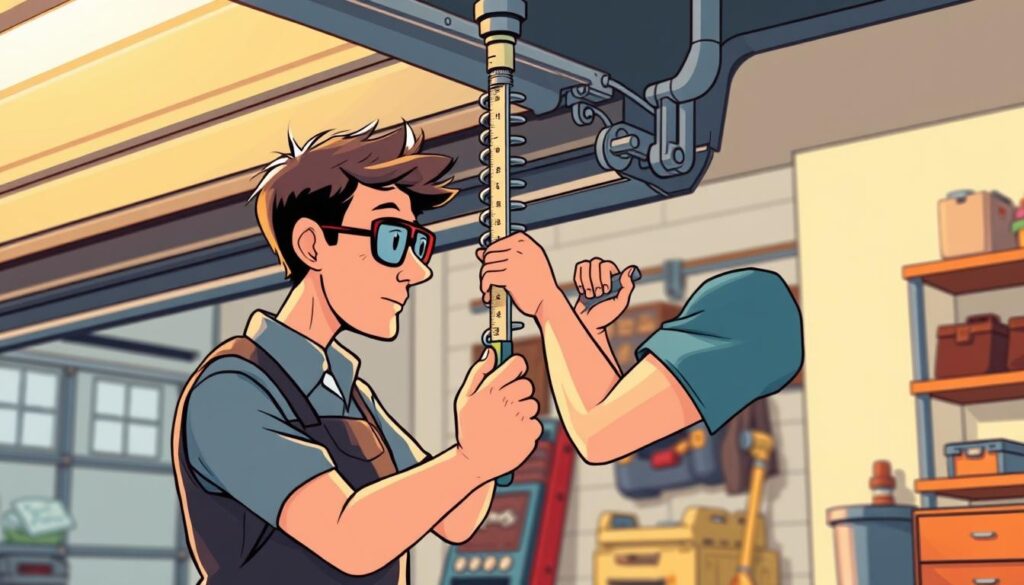Garage door springs help balance the door’s weight and make it move smoothly. It’s important to check the spring tension to keep everyone safe. Torsion springs, found in most homes, need to be adjusted just right.
Ignoring signs of wear can cause big problems. This includes corrosion or fraying. It might lead to expensive fixes.
This guide shows you how to check garage door spring tension in three steps. First, check how the door moves. Then, test the spring’s function. Lastly, adjust as needed.
Remember, safety first. Springs that are too tight can hurt you. If your door closes too fast or won’t close at all, there might be a problem.
Using silicone lubricant helps keep things running smoothly. But, if you’re not sure what you’re doing, get a pro. Regular checks keep your door working right and your family safe.
What is Garage Door Spring Tension?
Garage door spring tension is the force in the springs that balances the door’s weight. It makes sure the door moves smoothly and safely. If the tension is off, the door might strain or be hard to open by hand.
Understanding Spring Functionality
Spring systems use metal coils to store energy. When stretched or compressed, they release this energy to lift the door. A balance test shows if the springs are right. For example, a good system keeps the door up when not connected to the opener.
Types of Garage Door Springs
There are mainly two types: torsion and extension springs. Torsion springs are above the door and are tightly wound. Extension springs are on the sides and need safety cables. Here’s a quick look at their differences:
| Type | Installation | Pros | Cons |
|---|---|---|---|
| Torsion | Horizontal above door | Longer lifespan, easier adjustments | Requires precise winding |
| Extension | Vertical on door sides | Easier visual inspection | Risk of spring recoil if damaged |
Garage door length affects spring rotation for correct tension:
- 6.6 ft door: 7 turns
- 7 ft door: 7.8 turns
- 7.6 ft door: 8 turns
- 8 ft door: 8.8 turns
Tools like winding bars and wrenches are needed for adjustments. Regular checks help avoid problems like uneven movement or loud noises.
Importance of Proper Spring Tension
Keeping the right spring tension is key for safe and smooth garage door use. If springs are off, the door won’t work right and could be dangerous. It’s important to check the spring tension often to avoid big problems.
Effects on Garage Door Operation
- Uneven Movement: If springs are too loose or tight, the door might jerk or get stuck.
- Noise Issues: Sounds like screeching or grinding mean the springs are worn out.
- Weight Imbalance: If the door won’t stay open or slams shut, it’s a sign of lost tension.
Safety Risks of Improper Tension
Not paying attention to spring tension can be very dangerous. Torsion springs can hurt you if they break—over 10,000 people get hurt each year. If springs are too loose, they might break and drop the door.
Experts like Dlouhy Doors say wrong tension can cut spring life in half. But, regular checks can add 30-50% to their life, saving you money.
“A well-maintained spring system reduces risks by 60%.”
Always put safety first—don’t touch the springs yourself. If your door feels heavy or makes weird noises, call a pro right away.
Tools Needed for Checking Tension
Before you start, get the right tools and safety gear. This makes sure you’re safe and do the job right.
Essential Tools for the Task
Here’s what you need:
- 2 vice grips (for securing hardware)
- 2 winding bars (16–18 inches long)
- 8-inch wrench and adjustable wrench
- Hammer (for light adjustments)
- C-clamps and masking tape (for marking adjustments)
A garage door spring tension scale helps a lot. But, you can also use visual cues if you don’t have one.
Safety Gear Recommendations
Wear these to stay safe:
- Heavy-duty gloves and safety glasses
- Closed-toe shoes (no flip-flops)
- A hard hat (recommended for overhead work)
- Long sleeves and fitted clothing (to avoid getting caught in mechanisms)
“Improper tools or skipped safety steps can lead to injury. Torsion springs store enough energy to cause severe harm if mishandled.”
Check springs every 6 months to make them last longer. Using a garage door spring tension scale helps you adjust right. Don’t skip safety gear to avoid injuries and expensive fixes.
Step 1: Inspect the Garage Door
Before you start the garage door spring tension test, do a full check. Turn off the garage door opener. Wear safety glasses and gloves. This step helps spot problems that could make checking garage door spring tension unsafe.
Visual Assessment of the Door
Check springs for rust, cracks, or damage. Cables should be tight and not frayed. Make sure screws and brackets are tight. Here’s what to look for:
| Normal Springs | Worn Springs |
|---|---|
| Smooth, rust-free surface | Rusted, cracked, or bent |
| Cables intact | Cables frayed or loose |
| Secure brackets | Loose or missing parts |
Checking for Obstructions
Clear tracks and rollers of debris. Make sure the door moves smoothly. Look for:
- Stones or ice trapped in tracks
- Misaligned tracks causing uneven movement
- Bent or stuck rollers hindering motion
A blocked path can mess up tension readings. Fix these problems first. Regular checks save money and make your door last longer.
Step 2: Test Spring Tension
First, make sure the garage door opener is turned off. To test the spring tension, lift the door manually. It should feel easy to move, needing less than 10 pounds of force.
- Open the door all the way and let it go. A well-tensioned door will stay open a bit.
- Lift the door halfway and then let it go. It should not slide up or down on its own.
Check the spring tension at different heights to find problems. Warning: DIY fixes can be risky. Always wear goggles and gloves to protect yourself from spring injuries.
“Torsion springs need careful adjustments. Wrong turns can break the spring.”
For extension springs, move the hook closer to the jamb if the door is too heavy. Torsion springs should have 1 turn for every foot of door height. See Safety Garage Door’s guide for more steps. Experts can spot wear like gaps in springs, which mean it’s time for a new one.
Step 3: Adjusting Spring Tension
Adjusting garage door spring tension needs care and precision. First, make sure the garage door opener is off. Wear safety gear too. Torsion and extension springs need different ways to adjust garage door spring tension.
Tightening the Springs
- Open the door all the way. Use a winding bar to reach the spring cone.
- For torsion springs: Loosen set screws but don’t remove them. Turn the bar clockwise in ¼-inch steps. A 7-foot door needs 7.8 turns for balance.
- Check the door’s movement after each turn. If it moves smoothly, stop. Tightening too much can wear springs by 50%.
Extension springs: Open the door fully, then move the S-hook up a chain link. This makes the spring tighter.
Loosening the Springs
- Reverse the steps: turn winding bars counterclockwise for torsion springs.
- For extension springs, move the S-hook down a link to loosen tension.
- Adjust both sides equally to avoid shortening spring life by 25%.
Test the door after making changes. If it moves wrong, adjust a little more. Never push the door to avoid spring breakage.
Experts can make adjustments safely, but DIYers can do small tweaks. If unsure, call certified techs (cost: $150–$300) to avoid big repair bills. Regular checks every six months can make springs last 25% longer with the right care.
When to Call a Professional
Garage door spring tension safety is very important. You can check tension yourself, but some jobs need a pro. Experts have the right tools and know-how for safe spring adjustments.
Signs You Need Expert Help
Broken or rusty springs mean you need a pro. Doors that won’t balance or make grinding noises also need help. If your springs are over seven years old or your door suddenly stops working, call a pro right away.
Trying to fix it yourself can be very dangerous. Over 30 people die each year from garage door spring accidents. Let experts handle garage door spring tension measurement and repairs to keep you safe.
Finding Certified Technicians
Look for licensed techs with insurance and good reviews. Make sure they have experience with spring adjustments and are certified. Companies like Commonwealth Garage Door suggest yearly checks.
Experts use special tools for safe garage door spring tension safety. They do precise measurements and follow safety rules. Always check if they follow industry standards for safe work.
FAQ
What is garage door spring tension and why is it important?
Garage door spring tension is the force that helps the door open and close. It keeps the door moving smoothly. Without the right tension, the door might not work right and could even close by itself.
How can I check my garage door spring tension?
First, look for any damage on the springs. Then, try lifting the door by hand. It should move easily. If it doesn’t, or if you hear strange noises, it might need attention.
What tools do I need to check and adjust garage door spring tension?
You’ll need winding bars, C-clamps, pliers, and a tension scale. Don’t forget a ladder and safety gear like glasses and gloves.
What are the signs of improper garage door spring tension?
Signs include trouble opening or closing the door. It might move unevenly or make too much noise. If it doesn’t stay open, it’s time to adjust the springs.
How do I adjust garage door spring tension safely?
To tighten, use winding bars for small adjustments. For extension springs, move the S-hook. To loosen, do the opposite. Always check and retest your work.
When should I call a professional for my garage door springs?
Call a pro if you see broken springs or rust. If you’re unsure or uncomfortable adjusting, it’s safer to get help. Make sure the technician is licensed and experienced.
Can I visually inspect my garage door springs myself?
Yes, you can look for rust, damage, or gaps in the springs. Also, check cables and hardware for any signs of wear. If you see problems, it’s time for a pro to take a closer look.
What safety precautions should I take when checking garage door spring tension?
Wear gloves, safety glasses, and closed-toe shoes. Be careful and use a sturdy ladder. Make sure the door is secure before you start. Using the wrong tools can be dangerous.


